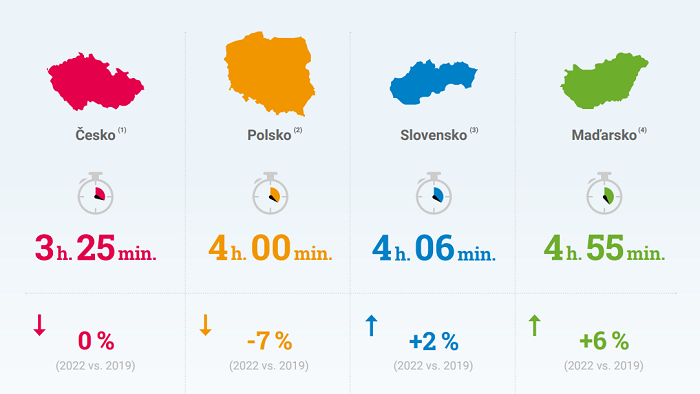In 2022, the average daily television viewing time (ATS) in the Czech Republic returned to the level from before the covid-19 pandemic. This is shown by a comparison of the Atmedia representative office, which on the Czech market is based on ATO-Nielsen Atmosphere data and which also compared viewership development in four countries of the Central European region. At the time of the pandemic (in 2020-2011), television viewership was above average. Slovakia saw a similar development to the Czech Republic last year. In Hungary, however, viewership continues to be at a higher level, while in Poland, on the contrary, it fell below the figures from 2019.
 Průměrná denní doba televizní sledovanosti v zemích visegradské čtyřky, zdroj: Atmedia
Průměrná denní doba televizní sledovanosti v zemích visegradské čtyřky, zdroj: Atmedia„TV viewing not only in the Czech Republic rose to record values in 2020 and 2021. The reason was, of course, the global covid-19 pandemic and the associated measures against its spread. Watching TV was one of the most common activities that people spent their time at home,”
describes Pavel Müller, Head of Research & Marketing at Atmedia.
According to him, the year 2022 returned to normal in terms of television viewership, with people spending a similar amount of time watching television as in the years before the pandemic. Czech viewers over the age of four spent an average of 3 hours and 25 minutes a day in front of television screens last year, which is only one minute less than in 2019. In the adult target group of 15+, television viewing was an average of 3 hours and 44 minutes a day , which is, on the contrary, two minutes more than in 2019. Last year, an average of 68% of Czech television viewers, i.e. 6.5 million people, turned on the television every day.
"In 2022, television viewership returned to its average values from 2010 to 2019. Last year also confirmed that television viewership in the Czech Republic has been stable for a long time and has been growing slightly in the last ten years. Last year, TV viewers over the age of fifteen spent an average of 12 more minutes a day watching TV compared to 2012," Müller adds, pointing out that the trend is the opposite for younger target groups of viewers.
In Hungary, television viewership has been maintained at almost 5 hours a day for three years
In comparison to the surrounding countries of the so-called Visegrad Four, television viewership in the Czech Republic has been the lowest for a long time. Slovak, Polish and Hungarian viewers spend more than four hours a day in front of their television screens. For example, in Hungary, which is one of the countries with the highest TV viewership not only in the Central European region, people spent the same amount of time watching TV last year as in 2020 and 2021, which were marked by the global covid-19 pandemic. For three years in a row, Hungarian viewers over the age of four watched television for an average of 4 hours and 55 minutes a day, which was 16 minutes more than in 2019.
Conversely, in Slovakia, similar to the Czech Republic, last year's values returned to a similar level as before the 2019 pandemic. Slovak viewers spent an average of 4 hours and 6 minutes a day watching television, which was four minutes more than in 2019. In Poland the opposite trend occurred. Television viewership here fell below the values of 2019 – specifically to 4 hours a day, i.e. 18 minutes less than in 2019.
Younger viewers watch less, returning to screens having kids
The year 2022 confirmed the long-term trend of a decline in television viewership among younger target groups of viewers. For example, Czech viewers aged 15-24 spent an average of 51 minutes a day watching television last year, which was 9 minutes less than in 2019. which is spent watching television is certainly not negligible. For example, viewers aged 25-34 watch TV on average over 2 hours a day," points out Pavel Müller, adding that viewers from this category who have children spend even more time in front of TV screens. Last year, specifically, it was an average of 2 hours and 23 minutes per day.
It is also similar in the neighboring states. An example can be Poland, where television viewership among viewers aged 15-24 fell, just like in the Czech Republic, to below 1 hour a day. The exception is again Hungary, where compared to 2019, not only older age groups watched TV more, but also, for example, viewers aged 15-24.
Source: mediaguru.cz


